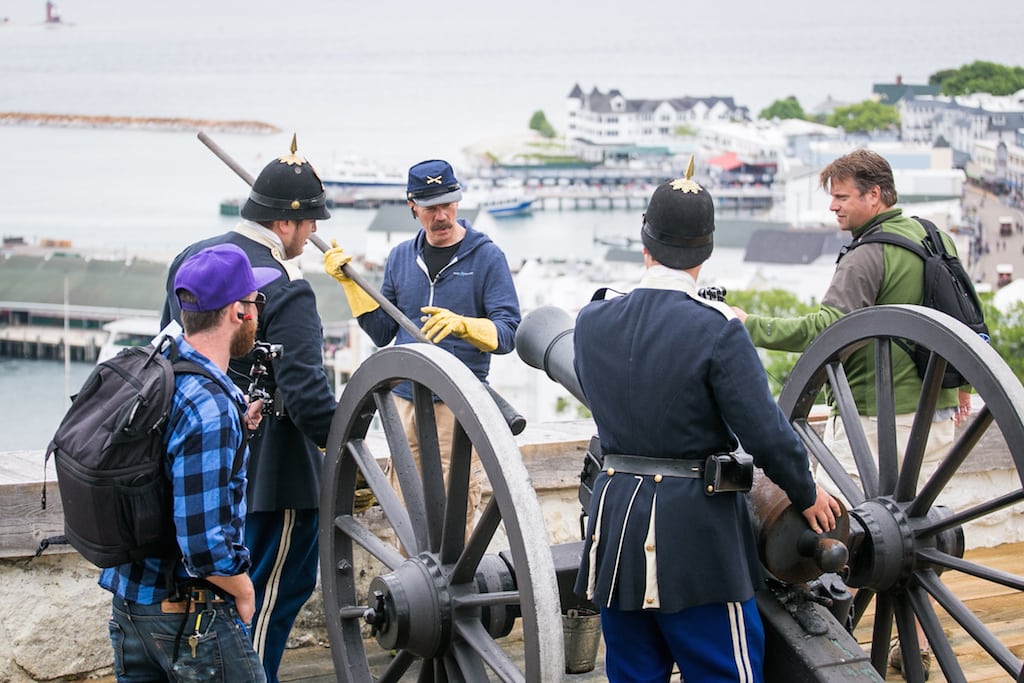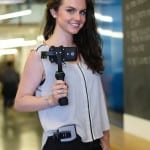Skift Take
Georama is unique because meeting attendees can now interact with any other group moving around in a non-static environment, via both HD video feed and social media chat in real time.
- Filming a Pure Michigan campaign with Georama equipment (far left)
- A sample view of Georama video social media chat
- The Georama personal “Pro” version launches this month
Georama is a new video technology platform that connects large audiences—such as a ballroom full of meeting attendees or thousands of individual travelers online simultaneously at home—with a remote group of people traveling around a destination almost anywhere in the world in real time.
Those audiences can also interact with the subject group live via Twitter and Facebook comments to help direct the virtual experience through the two-way engagement functionality.
The platform opens up new ways for destination marketing organizations (DMOs) to show meeting attendees and leisure consumers new local travel product and experiences, and it answers the growing demand for more mobile connectivity and social interactivity in destination meetings and events.
Nihal Advani, founder and CEO of Georama, introduced the platform at the Destination Marketing Association International (DMAI) annual conference last month. With over 3,000 people in the main ballroom at the Austin Convention Center, Advani showed a live video on the ballroom screen of a Georama host walking through Austin’s eclectic South Congress neighborhood while interviewing local restaurant owners.
Along with the host, another Georama member was carrying a stabilized GoPro camera and a backpack with the company’s proprietary equipment and software that stitches together all of the available Wi-Fi and multiple cellular network signals in any given place to create the most powerful broadband possible. That allows the host to move from place to place while delivering a consistent HD video feed, almost like any broadcast reporter except without requiring the aid of a broadcast satellite truck.
At the same time, the ballroom audience posed questions to the live video host via their social media channels that then appeared as a social stream running down the right side of the ballroom’s video screen.
Because the video host is busy focusing on navigating the destination and speaking with the video’s subjects and the ballroom audience at the same time, there’s also a remote Georama facilitator who curates the social media conversation. The facilitator chooses the most interesting social media commentary from the audience and then relays those to the host through the host’s earpiece.
“The guide is essentially giving all these other people anywhere in the world a vicarious experience or a preview of what it’s like to be in that destination,” says Advani. “If you look at any video medium, whether it be YouTube or TV, even live TV, it’s always been a one-way medium. We’re bringing the outside world in. Our ability to provide an HD-quality feed by combining multiple networks, while being mobile outdoors and having a two-way interaction—that’s really what’s new about this.”
During the DMAI presentation, almost no one in the audience seemed to be looking at their phone unless they were sending a message to the host, which is unheard of with most ballroom events. The combination of being able to engage the video host and his subjects in real time, the novelty of the social media interactivity, and learning about cool restaurants in Austin in a new way kept the audience fully engaged, which is the primary goal for any meeting planner.
“Our technology allows us on to have a great stream in any area, as long as it’s not a dead zone completely,” explains Advani. “There has to be some kind of network, but even in poor network conditions, we’re able to amplify five times, sometimes up to eight times, the strength of the regular network, thereby providing an HD-quality stream all done in very low latency.”
From the meeting planner/buyer perspective, they value the level of attendee attention and engagement that Georama potentially provides. From the supplier side, a destination can promote local insider experiences, special events, new venue launches, etc., with more impact than static one-way presentations.
The first big test for Georama took place on June 11 when the Michigan Economic Development Corporation (MEDC) hosted a virtual exploration of Mackinac Island with Tom Daldin, host of the popular PBS show, “Under the Radar Michigan.” Daldin and his crew rode bikes and carriage tours to show off the coastal views while answering social media questions posed by the virtual audience.
Advani says the show reached over 3,500 people from 22 countries watching the audio and video livestream on every imaginable digital device. The MEDC again worked with Georama on July 17 to promote the Detroit Zoo. Advani uses the analogy that DMOs can kind of create their own Anthony Bourdain show, except it’s live, uncut and interactive.
“For DMOs, they have several different kinds of media, and a lot of it on the video side is highly produced,” he explains. “There’s a place for that, from TV ads to other things, but I think there’s a need for this authentic storytelling also. This all happens in real-time, so you can’t edit it. You can’t beautify it more than it is.”
New Georama Pro Version
The DMAI presentation was an example of Georama’s Enterprise version of the equipment in action. This month, Advani is introducing a new personal Pro version that fits inside a pocket or purse and syncs wirelessly with a person’s smart phone. The Pro technology doesn’t have the capability to access the optimal volume of Wi-Fi and cellular signals as the Enterprise version, but it can still combine a selection of a few, making it more powerful than a typical smartphone connection.
“So basically we’ve made a self-serve platform where you can see the comments from your personal virtual audience that you manage and answer on your own,” says Advani. “That, we think, has massive potential opportunities for meetings.”
Hotels such as the Hyatt Regency Chicago have signed on with Georama to help meeting planners conduct live site visits with a virtual audience using the Pro platform. When a prospective meetings client is interested in exploring the Hyatt, the onsite meeting planner can walk through the property’s spaces while a team of colleagues back at the office can join in for a personalized virtual tour.
In another scenario, using either the Pro or Enterprise versions, meeting attendees can walk a tradeshow floor with the Georama equipment. Advani, who used to work at Microsoft, says there were times when the company could only send 15-20 people to a conference, but another 50-100 wanted to attend.
“So maybe Microsoft gets its own stream because there are 50 vendors that they want to try and meet to network with, and then Dell has its own thing,” he suggests. “The goal is not to cannibalize physical traffic. The goal is to expand upon the existing foot traffic.”
Have a confidential tip for Skift? Get in touch
Tags: DMAI, meetings and events
Photo credit: Filming the Pure Michigan campaign with Georama equipment (far left). Georama



